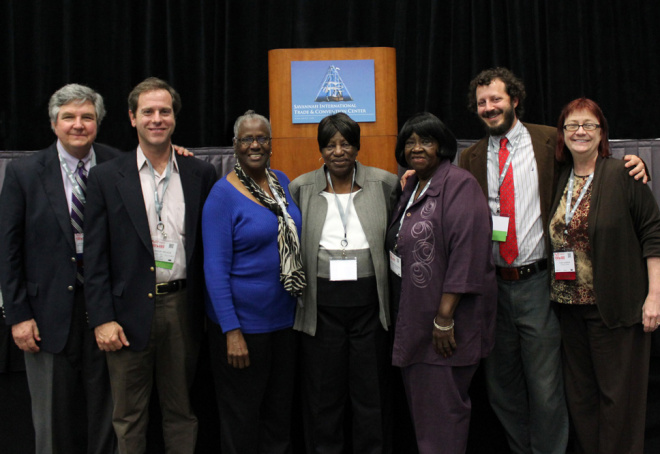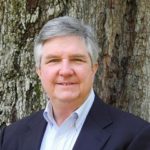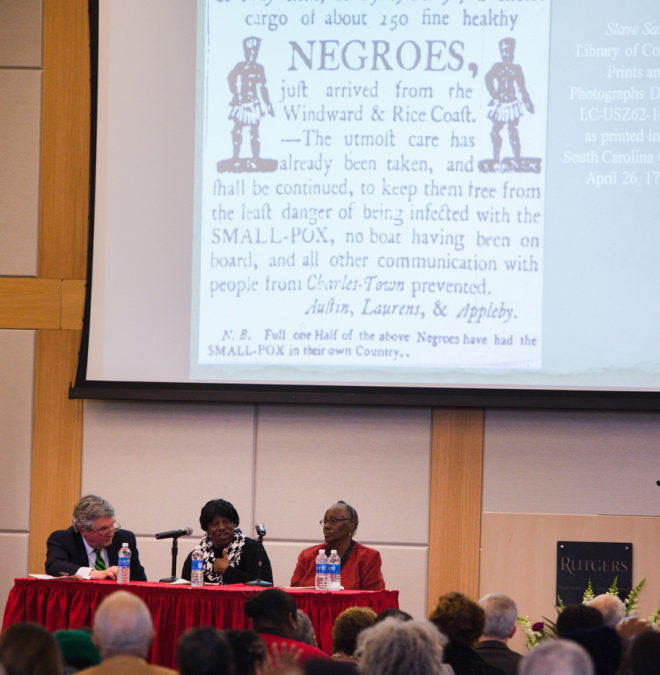Looking Back and Looking Forward at Drayton Hall with George McDaniel
By Special Contributor Elizabeth Byrd Wood
From The Preservation Leadership Forum Blog – Posted July 9, 2015
For the last two decades, historic sites around the country have been engaged in a steady, thoughtful discussion about slavery and race. This conversation isn’t always comfortable or easy, but it happens consistently and it happens with the authenticity and veracity that can only happen in an old place, in a place where history happened and history is preserved, and history is connected to the present. This year the Preservation Leadership Forum blog takes a look at National Trust Historic Sites and how their interpretation of slavery has evolved and changed over the years. The full series is available here. In this month’s post we took a moment to catch up with George McDaniel, the executive director of Drayton Hall, about the evolution of slavery interpretation at his site.

Drayton Hall with the Ashley River. The goal is to “people” the landscape by interweaving African American history throughout the site and telling stories of specific individuals like the boatsmen Tim and Toby, who plied the Ashley River and beyond. | Credit: Drayton Hall Preservation Trust
A day after the tragic shooting at Emanuel AME Church in Charleston, South Carolina, Drayton Hall director George McDaniel and his staff were still trying to comprehend the enormity of the event. Yet McDaniel, who is retiring in September after 26 years of overseeing Drayton Hall, still firmly believes that an understanding of history—both the good and the bad—has increasing relevance in today’s world and can bring people together to work through what he calls “troublesome” history.
In a recent interview, McDaniel spoke with conviction about the crucial role of historic sites in telling the full story of the nation’s history and in dispelling falsehoods and misperceptions. “It is even more important now to use historic sites to build cross-racial bridges,” according to McDaniel. He goes on to note that African American history is integral to American history, and people who claim otherwise are historically illiterate. “There is no ‘their’ or ‘my’ history, only ‘our’ history,” he says.

The “Connections” program supplements the house tour and engages the audience in discussions by featuring historical documents, maps and photographs as well as hands-on activities. | Credit: Drayton Hall Preservation Trust
For many years, Drayton Hall was known primarily for its exceptionally fine architecture as the earliest example of Palladian architecture in the United States. But, soon after his arrival, McDaniel and his staff realized that just telling the story of the Draytons, wealthy South Carolina planters, and their elegant house and the surrounding landscape was not enough. A crucial part of the story was missing—the story of people of African descent who worked at Drayton Hall during slavery and after emancipation. “We needed to tell the honest story of Drayton Hall,” explains McDaniel. “By interweaving African American history into the existing narrative, we could tell a more truthful and accurate story of our community and our nation. We knew that to do otherwise would defraud the past.”
To revise the house tours, staff conducted additional research and expanded their training program so that interpreters could talk more accurately about what life was like for African Americans during slavery and after emancipation. One strategy they used was to switch from passive verbs to active verbs. McDaniel explains: “Instead of saying, ‘The rice was planted,’ we needed to explain who planted the rice. And instead of the saying ‘the meals were prepared,’ we needed to explain who prepared the meals.
McDaniel cites the example of two enslaved men named Tim and Jack, “boatsmen” who sailed a sloop between Drayton Hall and the family’s network of coastal plantations, transporting crops, livestock, and other goods back and forth. On the one hand, as the interpreters discuss with visitors, Tim and Jack were enslaved and hence were owned as “property” for the rest of their lives, but on the other hand, their sailing the sloop demonstrated a high degree of skills and autonomy. The result is a more nuanced interpretation, one that prompts visitors to embrace new insights and to “people” the landscape with active individuals.
Drayton Hall also developed 30-minute interactive program, called Connections: From Africa to America, which focuses on African American history at Drayton Hall and complements the house tour. The interpreter provides copies of original documents, photographs, and maps that illustrate African American history at Drayton Hall during slavery and into the 20th century. The interpreter invites discussion and questions, highlights specific individuals, and to extent possible, engages them in hands-on activities. As a result, visitors leave with more in-depth understanding of the history of the region and a closer personal connection to African American history as it was lived out on this specific site.

Descendants of slaveholders and the enslaved participate in session at National Trust annual conference, 2014: l-r, George McDaniel; Shelby Nelson; Catherine Braxton; Rebecca Campbell; Annie Meyers; Charles Drayton; anthropologist Toni Carrier. A model session for other historic sites. | Credit: Drayton Hall Preservation Trust
Drayton Hall has also opened the African American cemetery at Drayton Hall to visitors and reached out to descendants of the enslaved community to share oral histories. Documented to the late 1790s, the cemetery is one of the oldest African American cemeteries in the nation still in use. For its dedication in 2009, McDaniel formed a committee of both African American and Drayton family descendants, along with historians and staff, and asked descendants of each family to speak at the ceremony. The result was a moment of cross-racial bridge-building, which, according to McDaniel, historic sites are so well positioned to build if the will is there. Driving that will is the recognition that our history, if honestly told in an inclusive manner, does have discomforting elements. “But that is what drives us to change and encourages us to push forward,” he says.
McDaniel notes that slavery is not just a side chapter of our history. “It is woven into the entire narrative of American history,” he says. But he reminds us that African American history is more than slavery. And it is no longer just a Southern narrative, but a part of the national story.
Engaging the community in the interpretation of the site is important to McDaniel. For example, he notes that it is important to remember that the buildings, places, and objects in collections are not the provenance of curators and historians only. It is important to ask community members what those things and places mean to them. “By getting different perspectives and multiple stories, you will enrich your interpretation,” he says. “Just as a novelist looks at the same event from different points of view, so too can we at historic sites, especially thanks to new technologies.”
Much of the work at Drayton Hall has served as a model for other historic sites, and McDaniel continues to speak at conferences about the role of historic sites in telling the full story of America. He recently spoke at the Marion Thompson Wright Lecture Series at Rutgers University in Newark on the topic of “Towards a More Complete History: Connecting Places and People by Engaging Descendants“.
With him were Rebecca Campbell and Catherine Braxton, great granddaughters of Catherine Bowen, a former slave who continued to live and work at Drayton Hall after emancipation. McDaniel, who has a pronounced Southern accent, said that he was told by a woman in the audience that at first the multiracial audience from New Jersey, upon hearing his accent and looking at the group from a plantation site, was wondering, “Just who is this guy?” But at the end, the audience member said that his message was fully embraced by the audience. “We can use history to bring people together, not divide,” McDaniel remarks.

Descendants of Drayton Hall, Catherine Braxton and Charles H. Drayton III, greet one another at oral history program with descendants, recently sponsored by Drayton Hall. Behind them are other descendants, l-r: Shelby Nelson, Rebecca Campbell, Charles Drayton, Frank Drayton and his wife Marley Drayton. | Credit: Drayton Hall Preservation Trust
McDaniel says that after he leaves Drayton Hall he wants to use his time to focus on family, research, and writing. With years of experience behind him, he wants to share his suggestions for historic sites going forward. He encourages historic sites to take part in more partnerships and cites the example of Drayton Hall’s collaboration with the Digital Archaeological Archive of Comparative Slavery (DAACS) as a successful partnership for sharing information and data from archaeological excavations. He encourages other sites to focus on outreach and to expand education programs to engage students.
He also suggests that sites take more note of the complexity of gender at historic sites, especially the places where women worked. And finally he notes the need for more minority staff and board members. He comments, “We need a larger pipeline of African Americans, Hispanics, and other immigrant groups entering the preservation field.”
Put simply, McDaniel has gotten people—all people—talking. Talking about slavery, wealth, freedom, social justice, recognition and reconciliation. Going back to the recent tragedy in Charleston, McDaniel and his staff agree that the people of the city are going in the right direction. “They are talking to each other about difficult topics, and the question now is: What do we do next to change for the good?” And answering that question is his hope for the future.

About the author: Elizabeth Byrd Wood is senior content manager at the National Trust for Historic Preservation.
 George W. McDaniel, Ph.D., is President of McDaniel Consulting, LLC, a strategy firm that helps organizations use history to build bridges within itself and to its broader constituents. The company’s tag line, “Building Bridges through History,” is grounded in McDaniel’s personal beliefs and his experience in site management, preservation, education, board development, fundraising, and community outreach. Rather than using history to divide us, he strives to help organizations use history, especially local history, to enhance cross-cultural understanding and to support local museums, preservation, and education. Dr. McDaniel recently led volunteer efforts with Emanuel AME Church and historical organizations in Charleston to use historic preservation to enhance racial reconciliation and healing.
George W. McDaniel, Ph.D., is President of McDaniel Consulting, LLC, a strategy firm that helps organizations use history to build bridges within itself and to its broader constituents. The company’s tag line, “Building Bridges through History,” is grounded in McDaniel’s personal beliefs and his experience in site management, preservation, education, board development, fundraising, and community outreach. Rather than using history to divide us, he strives to help organizations use history, especially local history, to enhance cross-cultural understanding and to support local museums, preservation, and education. Dr. McDaniel recently led volunteer efforts with Emanuel AME Church and historical organizations in Charleston to use historic preservation to enhance racial reconciliation and healing.
McDaniel is also the Executive Director Emeritus of Drayton Hall, a historic site in Charleston, SC, owned by the National Trust for Historic Preservation. He retired from Drayton Hall in 2015 after 25 years of distinguished service.
Header Image: L-R George McDaniel and descendants Rebecca Campbell and Catherine Braxton at Rutgers University in Newark. As images of historical documents and artifacts were shown, the two sisters articulated their feelings and thoughts about what the things meant to them, thereby galvanizing the audience’s engagement and creating additional layers of significance. | Photo by Fred Stucker, courtesy of Curating Black America: the 35th annual Marion Thompson Wright Lecture Series, Rutgers University-Newark.

 McDaniel Consulting LLC is a strategy firm that helps organizations use history to build bridges within itself and its broader constituents.
McDaniel Consulting LLC is a strategy firm that helps organizations use history to build bridges within itself and its broader constituents.